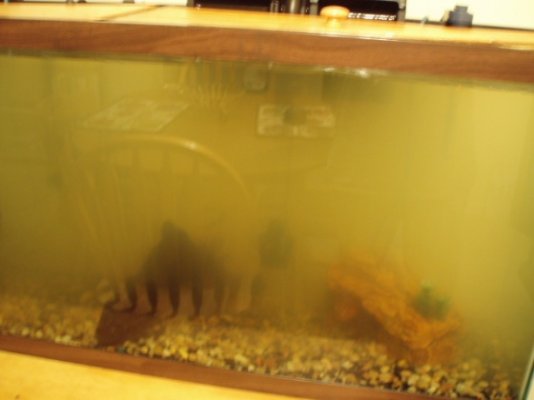None of the following relates to your actual question, as I can't see the picture from my mother-in-law's dial-up connection, so this is just advice from the text part of your post.
If your filter needs cleaning, wait until you change water and just rinse it in the bucket of old tank water. You should never replace the filter pad as long as it is mechanically intact, and when it comes time to do it the best thing is to add the second filter behind the old one and run both together for at least a week, preferably two.
You should start by reading the article that's stickied at the top of this forum on cycling a tank. Since you have fish already you won't be doing everything it recommends, but you do need to have a basic understanding of the water chemistry discussed there.
Short version:
Protein in your tank from uneaten food and fish poop is broken down by bacteria in the water or poop into ammonia. The fish also secrete ammonia directly in urine. Ammonia is highly toxic to your fish in any significant amounts, and even in small amounts it causes them a lot of stress and will make them susceptible to all sorts of diseases and parasites. Breathing ammonia is not a good thing.
Certain species of bacteria are adapted to "eat" ammonia. These are not present in your tank initially in any large numbers because there was not a source of food for them at first. Once an ammonia source is provided (the fish) they will begin to establish themselves. The filter is the best place for them to live because all the water in the tank is eventually washed past it, so all the food comes to them there. The filter material also provides lots of surfaces for them to settle on. The establishment of this biological filtration removing ammonia is essential to the health of your fish, and if you throw out the filter pad periodically you're starting over each time.
The first colonies of bacteria, unfortunately, produce a waste product (nitrITE, NO2) which is itself toxic, and a second colony of a different species of bacteria will eventually form which eats that and converts it into relatively harmless nitrATE (NO3).
The first step is:
- Stop throwing out filter pads. When they get dirty, rinse the dirt out in tank water (chlorine in tap water will kill your bacteria so don't rinse them in the sink). They will still look brown, and that's fine.
- Get test kits for the chemicals I mentioned above. At a minimum you need an ammonia and a nitrite test kit. Most people here will recommend you test for nitrate also, but if you change water regularly your fish will survive without this one. These tests are available at most any pet store, and will generally be located near the fish medication stuff. Get a liquid test kit, not the little paper strips (those are notoriously inaccurate, although cheap). Most often recommended is the API Master kit, which you can find around $30 online, but if you wanted the minimum kit you can buy the ammonia and nitrite tests separately for $6-8 each.
Those chemicals need to be monitored frequently, preferably daily, until you know the bacteria are established. This is done by changing some water every time ammonia or nitrite reaches or exceeds 0.5 ppm (parts per million). At first expect to see some ammonia and zero nitrite, and that will continue for some time - 3 to 5 weeks if you were starting from scratch, but your tank may have some bacteria in it already. Eventually you'll see the ammonia drop quickly to zero and you'll have nitrite present. When the nitrite goes away then your tank is settled and will take care of itself.
Not necessarily related:
If your pH is changing there is a problem. That isn't good for the fish and it indicates that there is something rotting in the tank and producing acid. Find it and remove it (could just be fish poop settled into the gravel). Don't use pH Up or Down to try to adjust your pH. These chemicals generally have a short-lived effect and the change in pH will stress your fish when you add it and when it wears off. The fish will adapt to the water you put them in, at a wide range of pH, but they can't adapt if it's always changing.


